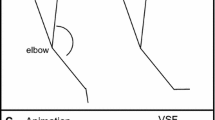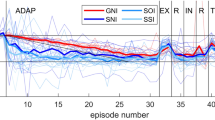Abstract
We tested whether observational practice would elicit after-effects in a normal environment following observation of an actor performing in a perturbed visuomotor environment. Two actor groups (with and without vision of the hand) practised reaching to visual targets with the cursor rotated 30° to the actual hand movement. An observer group viewed this adaptation. Observers demonstrated significant learning when they subsequently performed the aiming task in the perturbed environment. However, different from both actor groups, observers did not show after-effects in the normal visuomotor condition. Our findings imply that there is a qualitative difference in the processes between observational and physical practice and suggest that physical exposure is required to update an internal model of the visuomotor environment.




Similar content being viewed by others
References
Ashford D, Bennett SJ, Davids K (2006) Observational modeling effects for movement dynamics and movement outcome measures across differing task constraints: a meta-analysis. J Mot Behav 38:185–205
Bandura A (1986) Social foundations of thought and action: a social cognitive theory. Prentice Hall, NJ
Baraduc P, Wolpert DM (2002) Adaptation to a visuomotor shift depends on the starting posture. J Neurophysiol 88:973–981
Bedford FL (1999) Keeping perception accurate. Trends Cogn Sci 3:4–11
Bernier PM, Chua R, Bard C, Franks IM (2006) Updating of an internal model without proprioception: a deafferentation study. Neuroreport 17:1421–1425
Blandin Y, Proteau L (2000) On the cognitive basis of observational learning: development of mechanisms for the detection and correction of errors. Q J Exp Psychol 53A:846–867
Blandin Y, Lhuisset L, Proteau L (1999) Cognitive processes underlying observational learning of motor skills. Q J Exp Psychol 52A:957–979
Brown LE, Wilson ET, Gribble PL (2009) Repetitive transcranial magnetic stimulation to the primary motor cortex interferes with motor learning by observing. J Cogn Neurosci 21:1013–1022
Buchanan JJ, Ryu YU, Zihlman K, Wright DL (2008) Observational practice of relative but not absolute motion features in a single-limb multi-joint coordination task. Exp Brain Res 191:157–169
Carroll WR, Bandura A (1990) Representational guidance of action production in observational learning: a causal analysis. J Mot Behav 22:85–97
Clower DM, Boussaoud D (2000) Selective use of perceptual recalibration versus visuomotor skill acquisition. J Neurophysiol 84:2703–2708
Cunningham HA, Welch RB (1994) Multiple concurrent visual-motor mappings: implications for models of adaptation. J Exp Psychol Hum Percept Perform 20:987–999
Gallese V, Fadiga L, Fogassi L, Rizzolatti G (1996) Action recognition in the premotor cortex. Brain 119:593–609
Gazzola V, Rizzolatti G, Wicker B, Keysers C (2007) The anthropomorphic brain: the mirror neuron system responds to human and robotic actions. Neuroimage 35:1674–1684
Gentili R, Papaxanthis C, Pozzo T (2006) Improvement and generalization of arm motor performance through motor imagery practice. Neurosci 137:761–772
Hayes SJ, Hodges NJ, Scott MA, Horn RR, Williams AM (2006) Scaling a motor skill through observation and practice. J Mot Behav 38:357–366
Held R (1965) Plasticity in sensory-motor systems. In: Thompson RF (ed) Progress in psychobiology: readings from scientific American. W.H. Freeman & Company, San Francisco, pp 259–266
Hodges NJ, Williams AM, Hayes SJ, Breslin G (2007) What is modelled during observational learning? J Sports Sci 25:531–545
Jeannerod M (2006) Motor cognition: what actions tell the self. Oxford University Press, New York
Kagerer FA, Contreras-Vidal JL, Stelmach GE (1997) Adaptation to gradual as compared with sudden visuo-motor distortions. Exp Brain Res 115:557–561
Kohl RM, Shea CH (1992) Pew (1966) revisited: acquisition of hierarchical control as a function of observational practice. J Mot Behav 24:247–260
Kurtzer I, DiZio PA, Lackner JR (2005) Adaptation to a novel multi-force environment. Exp Brain Res 164:120–132
Maslovat D, Hayes SJ, Horn R, Hodges NJ (2010) Motor learning through observation. In: Elliott D, Khan MA (eds) Vision and goal-directed movement: neurobehavioral perspectives. Human Kinetics, Champaign, pp 315–339
Mattar AG, Gribble PL (2005) Motor learning by observing. Neuron 46:153–160
Mazzoni P, Krakauer JW (2006) An implicit plan overrides an explicit strategy during visuomotor adaptation. J Neurosci 26:3642–3645
Oldfield RC (1971) The assessment and analysis of handedness: the Edinburgh inventory. Neuropsychol 9:97–113
Porro CA, Facchin P, Fusi S, Dri G, Fadiga L (2007) Enhancement of force after action observation: behavioural and neurophysiological studies. Neuropsychol 45:3114–3121
Redding GM, Wallace B (1993) Adaptive coordination and alignment of eye and hand. J Mot Behav 25:75–88
Redding GM, Wallace B (1996) Adaptive spatial alignment and strategic perceptual-motor control. J Exp Psychol Hum Percept Perform 22:379–394
Redding GM, Wallace B (2002) Strategic calibration and spatial alignment: a model from prism adaptation. J Mot Behav 34:126–138
Rizzolatti G, Craighero L (2004) The mirror-neuron system. Annu Rev Neurosci 27:169–192
Rizzolatti G, Fadiga L, Gallese V, Fogassi L (1996) Premotor cortex and the recognition of motor actions. Cogn Brain Res 3:131–141
Scheidt RA, Reinkensmeyer DJ, Conditt MA, Rymer WZ, Mussa-Ivaldi FA (2000) Persistence of motor adaptation during constrained, multi-joint, arm movements. J Neurophysiol 84:853–862
Shadmehr R, Mussa-Ivaldi FA (1994) Adaptive representation of dynamics during learning of a motor task. J Neurosci 14:3208–3224
Shea CH, Wright DL, Wulf G, Whitacre C (2000) Physical and observational practice afford unique learning opportunities. J Mot Behav 32:27–36
Vogt S (2002) Visuomotor couplings in object-oriented and imitative actions. In: Meltzoff AN, Prinz W (eds) The imitative mind: development, evolution, and brain bases. Cambridge University Press, Cambridge, pp 206–220
Vogt S, Thomaschke R (2007) From visuo-motor interactions to imitation learning: behavioural and brain imaging studies. J Sports Sci 25:497–517
Acknowledgments
This research was supported by a Discovery grant to the second author from Natural Sciences and Engineering Research Council of Canada (NSERC).
Author information
Authors and Affiliations
Corresponding author
Rights and permissions
About this article
Cite this article
Ong, N.T., Hodges, N.J. Absence of after-effects for observers after watching a visuomotor adaptation. Exp Brain Res 205, 325–334 (2010). https://doi.org/10.1007/s00221-010-2366-4
Received:
Accepted:
Published:
Issue Date:
DOI: https://doi.org/10.1007/s00221-010-2366-4




